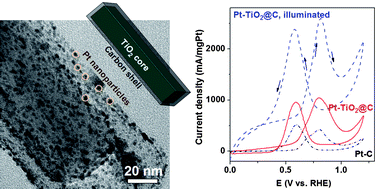Core–shell TiO2/C nanofibers as supports for electrocatalytic and synergistic photoelectrocatalytic oxidation of methanol
Abstract
Carbon-coated TiO2 fibers were synthesized as core–shell structured supports for highly dispersed Pt

* Corresponding authors
a
Department of Chemistry, The University of Hong Kong, Pokfulam Road, Hong Kong, China
E-mail:
hrsccky@hkucc.hku.hk
Fax: +852 2857 1586
Tel: +852 2859 7917
b
State Key Laboratory of Materials-oriented Chemical Engineering, Nanjing University of Technology, Nanjing, China
E-mail:
xhlu@njut.edu.cn
Fax: +86-25 83588063
Tel: +86-25 83588063
Carbon-coated TiO2 fibers were synthesized as core–shell structured supports for highly dispersed Pt

 Please wait while we load your content...
Something went wrong. Try again?
Please wait while we load your content...
Something went wrong. Try again?
W. Li, Y. Bai, F. Li, C. Liu, K. Chan, X. Feng and X. Lu, J. Mater. Chem., 2012, 22, 4025 DOI: 10.1039/C2JM14847A
To request permission to reproduce material from this article, please go to the Copyright Clearance Center request page.
If you are an author contributing to an RSC publication, you do not need to request permission provided correct acknowledgement is given.
If you are the author of this article, you do not need to request permission to reproduce figures and diagrams provided correct acknowledgement is given. If you want to reproduce the whole article in a third-party publication (excluding your thesis/dissertation for which permission is not required) please go to the Copyright Clearance Center request page.
Read more about how to correctly acknowledge RSC content.
 Fetching data from CrossRef.
Fetching data from CrossRef.
This may take some time to load.
Loading related content
